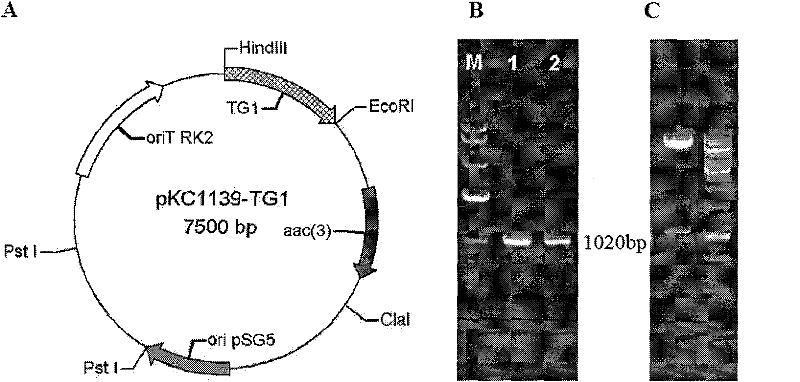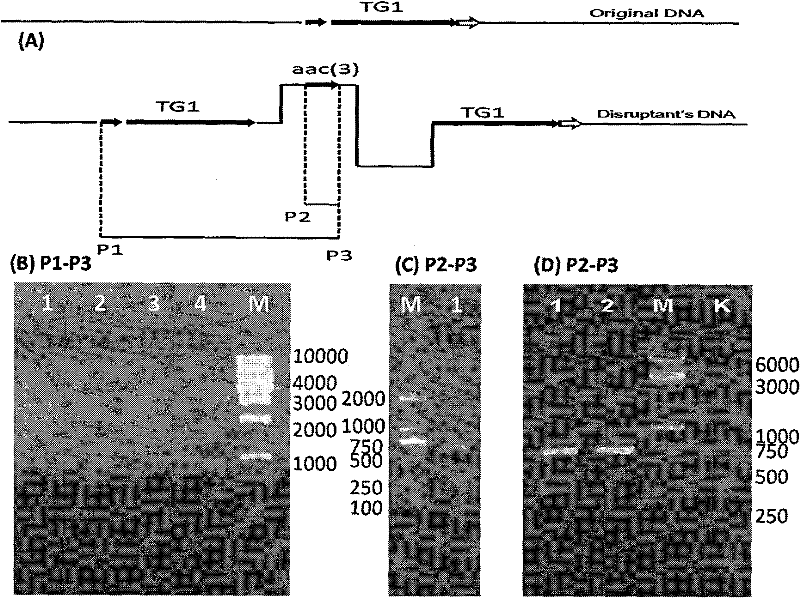Transglutam kinase coding gene interrupted streptomyces hygroscopicus and application thereof
A technology for encoding transglutaminase and Streptomyces hygroscopicus is applied in the field of genetic engineering to achieve the effect of simple, easy to implement and short-required gene blocking method.
- Summary
- Abstract
- Description
- Claims
- Application Information
AI Technical Summary
Problems solved by technology
Method used
Image
Examples
Embodiment 1
[0028] Interruption of Transglutaminase Encoding Gene in Streptomyces hygroscopicus in Example 1
[0029] 1. Acquisition of the target fragment gene TG1
[0030] Using primers:
[0031] Y1: 5′-TTTAAGCTT CCACTGTGAGTGCGGCGATA-3′ (underlined, boldface is the Hind III site); Y2: 5′-AAA GAATTC TTCCGTCTGAGCCCCAAACC-3' (underlined, boldface is the Eco RI site) was amplified from the genome of Streptomyces hygroscopicus to obtain the knockout fragment TG1.
[0032] The total volume of the PCR reaction was 25 μL, and 1 μL of Streptomyces hygroscopicus total DNA was used as a template for the reaction. The reaction conditions are: 95°C for 5 min; 95°C for 1 min, 65°C for 1 min, 72°C for 10 min, 30 cycles. The PCR product was a fragment of the MTG gene, named TG1, and verified by sequencing.
[0033] 2. Blocking vector construction
[0034] Digest bifunctional thermosensitive shuttle plasmid pKC1139 (6.5kb) with Eco RI and Hind III (Hopwood D, Bibb M, Chater KF e a. Genetic manipul...
Embodiment 2
[0057] Example 2. Verification of Streptomyces hygroscopicus transglutaminase gene function
[0058] 1. Inoculate recombinant strains for liquid medium and solid culture of Streptomyces hygroscopicus, and detect enzyme activity at different time periods. Wild strains can detect MTG enzyme activity, but recombinants cannot detect MTG enzyme activity during solid and liquid culture. see results image 3 .
[0059] 2. S.h-ΔTG was cultured on a solid plate, and the wild strain was used as a control, and the wild strain and the recombinant were inoculated to different areas of the same plate ( Figure 4 ), cultured at 32°C. During the early growth process of the bacteria, the hyphae in the substrate could grow normally. At 48 hours, the wild strain had completely differentiated to form aerial hyphae, while the recombinant S.h-ΔTG was still in the state of vegetative mycelium growth, and no aerial mycelium was formed. After continuing to cultivate for 120 hours, the wild strain S...
Embodiment 3
[0060] Example 3. Transglutaminase gene blocking Streptomyces hygroscopicus is used to express and produce transglutaminase
[0061] 1. The TGase gene fragment and the signal peptide fragment on the vector pIB13 vector and the expression vector pIJ8600 (Hopwood D, Bibb M, Chater KF e a. Genetic manipulation of Streptomyces[M]. A Laboratory Manual. In: Norwich: John Innes Foundation Press; 2000) respectively carry out Nde I and Xba I double enzyme digestion, after recovery, use T4 ligase to connect Figure 5 . The ligation reaction system is (10 μL): target gene fragment 2 μL, carrier DNA 2 μL, 10×T4 ligase Buffer 1 μL, T4 DNA ligase 1 μL, ddH 2 O 4 μL.
[0062] The ligation product was transformed into competent Escherichia coli JM109 for transformation. The conversion method is as follows:
[0063] (1) Under sterile conditions, take 200 μL of competent cells and place them in a sterile microcentrifuge tube;
[0064] (2) Add 1-2 μL of recombinant plasmid to each tube, rot...
PUM
 Login to View More
Login to View More Abstract
Description
Claims
Application Information
 Login to View More
Login to View More - R&D Engineer
- R&D Manager
- IP Professional
- Industry Leading Data Capabilities
- Powerful AI technology
- Patent DNA Extraction
Browse by: Latest US Patents, China's latest patents, Technical Efficacy Thesaurus, Application Domain, Technology Topic, Popular Technical Reports.
© 2024 PatSnap. All rights reserved.Legal|Privacy policy|Modern Slavery Act Transparency Statement|Sitemap|About US| Contact US: help@patsnap.com










